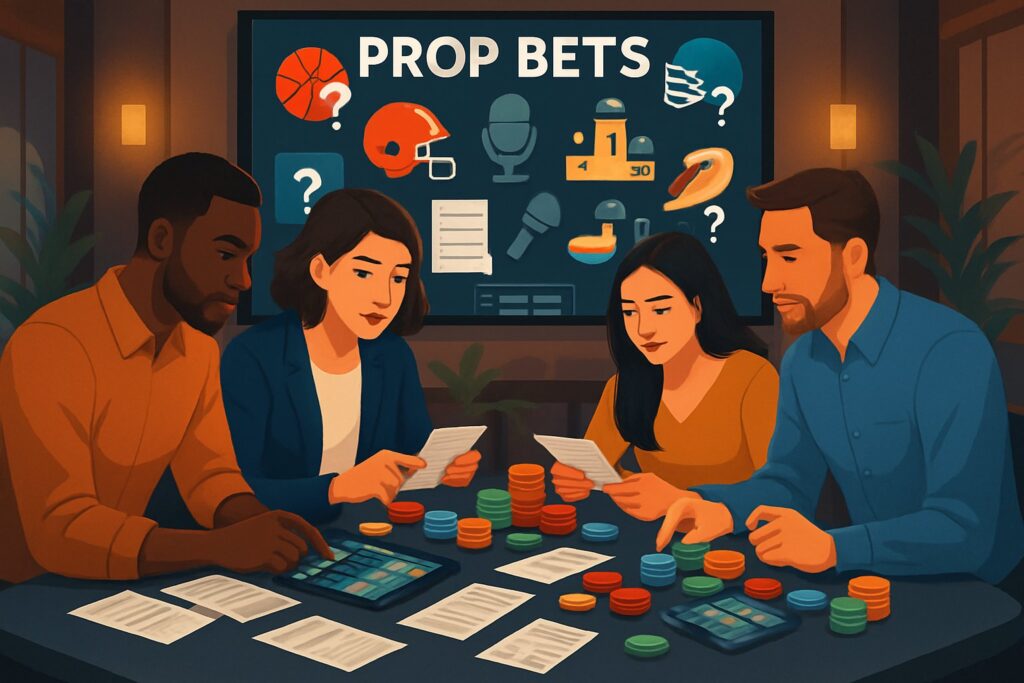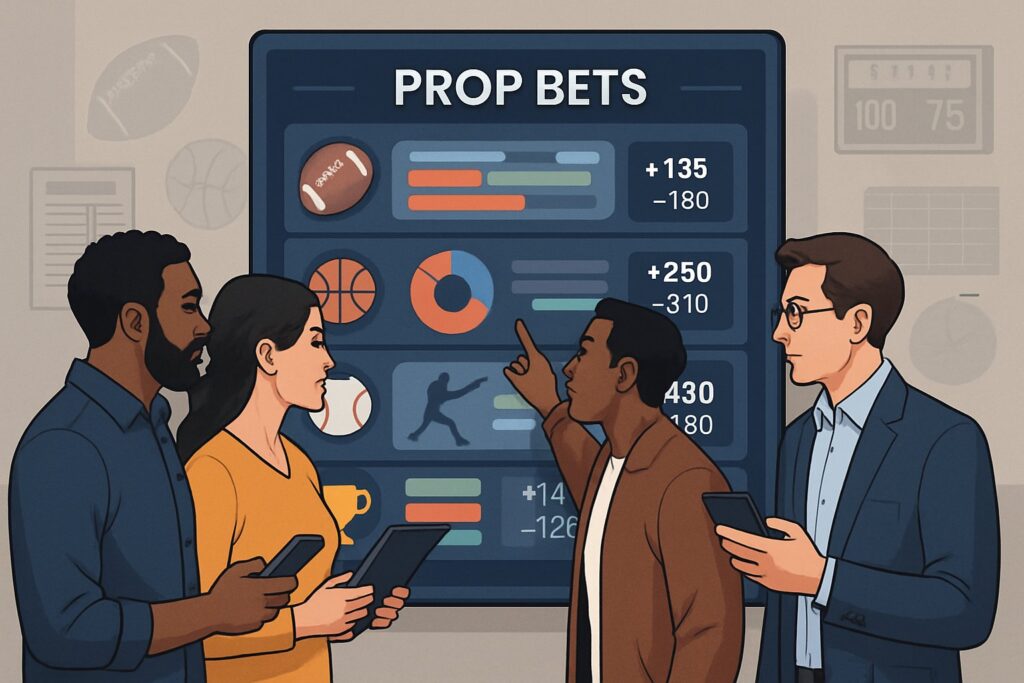by Martin Green
August 9, 2025
Last Updated on August 9, 2025 by Martin Green
Prop bets let you wager on specific events within a game instead of just the final score. You might focus on a player’s performance, a team milestone, or even something quirky like the outcome of a coin toss. A prop bet is any wager that isn’t directly tied to the game’s overall outcome.

Prop bets add some spice to your betting routine and let you zero in on the details you care about. You’ll see them everywhere in football, basketball, and baseball, but they pop up in niche sports too. That flexibility is a big part of their appeal if you like having more say in what you’re betting on.
Some props depend on skill and research, while others are pure luck. Knowing which is which helps you make better choices and, hopefully, avoid silly risks.

A prop bet, short for proposition bet, lets you wager on specific in-game events instead of the final score. You might bet on player performance, team milestones, or offbeat scenarios, which gives you more options than traditional moneyline or point spread bets.
A prop bet is a wager on a particular outcome that doesn’t always impact the game’s result.
So, instead of picking a winner, you could bet on whether a quarterback throws over 250 yards or if a basketball player sinks the first basket.
Prop bets can be player-based, team-based, or even totally unrelated to the gameplay, like guessing the length of the national anthem at the Super Bowl.
You’ll usually see them set up as Over/Under or Yes/No bets. For example:
Since these bets target specific moments, it pays to know the sport’s stats and context before you jump in.
Most prop bets fall into one of four categories:
| Type | Focus | Example |
|---|---|---|
| Player Props | Individual player performance | LeBron James Over 8.5 assists |
| Team Props | Team-specific outcomes | First team to score a touchdown |
| Game Props | Overall game events | Total combined points Over 45.5 |
| Novelty Props | Non-traditional or off-field events | Coin toss result |
Player props show up a lot in sports like the NBA, NFL, and soccer, where individual stats are easy to follow.
Team props highlight one team’s achievements in a game.
Game props involve both teams, like whether the match heads into overtime.
Novelty props usually pop up at big events like the Super Bowl or even outside of sports entirely.
Traditional wagers like moneylines, point spreads, and totals all focus on who wins or how much is scored overall.
With a moneyline bet, you just pick the winner. Point spreads shift the odds based on expected margins. Totals are about the combined score.
Prop bets, on the other hand, zero in on specific happenings within the game.
They don’t have to match up with the final outcome. Your prop on a player to score two goals can cash even if their team loses.
If you like focusing on matchups, player form, or oddball scenarios instead of the scoreboard, prop bets are probably more your style.

Prop bets center on specific outcomes in a game, not just the final tally. You might bet on player stats, team achievements, in-game events, or even stuff that has nothing to do with the sport. Usually, these bets use measurable stats like passing yards, assists, strikeouts, or the winning margin to settle up.
Player props let you bet on what a specific athlete does. You might look at passing yards, touchdowns, assists, blocks, or strikeouts.
For instance, in football, you could bet on a quarterback going over 250.5 passing yards. In basketball, maybe you’re eyeing a player to rack up more than 7.5 assists.
These bets are fun because you can focus on individual skills instead of the whole team. You can even pit players against each other, like which pitcher will notch more strikeouts in a baseball game.
Before you jump in, it’s smart to check a player’s recent form, opponent strength, and injury news. Even a small change in a player’s role or minutes can shake up these markets.
Team props look at how a single team performs in a game. You’re betting on what the group does, not just one person.
Some common ones:
In football, maybe you’re betting on a team scoring a touchdown in the first quarter. In baseball, you could go for a team’s total runs.
If you know a team’s style or have a good read on the matchup, these bets can offer value. Dig into offensive and defensive stats to spot opportunities.
Game props cover events involving both teams or the flow of the match. It’s not about one side’s performance.
Examples:
In basketball, you might bet on the combined score going over a set number. In hockey, maybe you’re guessing if there’ll be overtime.
Game props let you bet on pace, scoring trends, or specific situations without picking a winner. Handy when matchups are tight or unpredictable.
Novelty props (sometimes called exotic props) are for unusual or entertainment-related outcomes. They might connect to a sporting event or be totally unrelated.
In sports, you’ll see bets on the coin toss, national anthem length, or even whether a streaker shows up.
Outside of sports, you’ll find props for award shows or elections. These are mostly for fun and can be pretty unpredictable.
Since novelty props often involve rare or non-competitive events, stats don’t help much. Sometimes it’s just gut feeling or a weird bit of trivia that gives you an edge.
Prop betting changes from sport to sport because each game tracks different stats, milestones, and unique events you can bet on. The best markets usually focus on measurable stuff like yards, points, goals, or strikeouts, so you know exactly what needs to happen for your bet to win.
In the NFL, prop bets usually revolve around player stats and scoring. You might go for a quarterback’s passing yards, a wide receiver’s total receptions, or whether a running back scores a touchdown.
Some typical NFL props:
The Super Bowl is packed with props, from first-half scoring to the national anthem length. Regular season games still have plenty of player and team markets, especially in big matchups.
If you keep up with injury news, weather, and matchups, you might spot some solid bets. For example, strong winds can mess with field goals, while a weak secondary might make a QB’s passing yard prop more appealing.
Basketball prop bets – whether in the NBA or college – usually focus on stats like points, assists, rebounds, and blocks. You can also bet on things like which team scores the first 20 points.
Popular basketball props include:
In the NBA, player props hinge on pace and defensive matchups. In college hoops, team props can be more reliable since player stats swing wildly.
Check recent form, minutes, and injuries before betting basketball props. If a player just came back from injury, they might see limited minutes, which could tank their stats.
MLB props often focus on pitching and hitting stats. You might bet on a pitcher’s strikeouts, a batter hitting a home run, or which team scores first.
Common MLB props:
Pitcher-vs-batter matchups matter a lot. If a pitcher owns certain hitters, their strikeout prop looks good. On the flip side, a hitter with a strong record against a pitcher might be a smart pick for a hit or RBI.
Weather can shake things up too. Warm, windy days boost home run chances, while cold air keeps the ball in the park.
In the NHL, prop bets usually cover goal scorers, assists, shots on goal, and goalie saves. You might also bet on team events, like whether a game heads to overtime.
Popular NHL props include:
Player form and line combinations matter. A forward skating on the top line with talented teammates has a better shot at scoring or picking up assists.
Goalie props often hinge on the expected shot count. If a goalie faces a high-volume offense, save totals can spike, but a strong defense might keep shots down.
Ice quality, travel, and back-to-back games can all shake up NHL prop outcomes.
Prop bet odds show what you stand to win and how likely the outcome is. They shift from sportsbook to sportsbook, and even small changes can alter your potential payout. If you know how to read and compare these odds, you’ll make smarter wagers.
You’ll see prop bet lines as American odds (like +150 or -120), decimal odds (2.50), or fractional odds (3/2). Most U.S. sportsbooks – BetUS, BetOnline, and so on – use American odds.
A plus sign (+) means you win that amount on a $100 bet. So, +200 returns $200 profit on a $100 wager. A minus sign (-) tells you how much you need to bet to win $100. If you see -150, you’d have to risk $150 to win $100.
Some props list several outcomes, each with its own odds. For example:
| Outcome | Odds |
|---|---|
| Player scores first TD | +450 |
| Player scores second TD | +600 |
Always check your sportsbook’s odds format and make sure you know how the payouts work before betting.
Lots of prop bets use an Over/Under setup. You’re guessing if a stat will land higher (over) or lower (under) than the number the sportsbook sets. For example, “Over 2.5 passing touchdowns” means you need 3 or more for a win.
The Yes/No format pops up for event-based props. Like: Will Player X hit a home run? “Yes” could be +250, “No” might be -300. The odds reflect what the sportsbook thinks is likely.
That number next to your bet? It’s the payout odds. Sometimes, two sportsbooks use the same line but different odds – and that changes your possible return.
Odds for the same prop can shift between sportsbooks. EveryGame sportsbook might post “Over 1.5 goals” at +120, while Bovada bumps it to +135. That difference can matter on a winning bet.
You can use odds comparison tools or just bounce between a few sportsbooks on your own. Even tiny odds changes add up if you’re betting a lot.
Check that the bet rules line up. Some sportsbooks grade props differently, especially for player stats. Reading the terms before betting helps you dodge disputes over results.
Prop betting success comes down to prep, discipline, and spotting value in the odds. You give yourself a better shot by leaning on reliable data, managing your money, and picking wagers with the best terms.
Dig into the sport, players, and conditions tied to your prop bet. For player props, look at recent stats, injury news, and matchup history.
Situational stuff matters. In football, weather can mess with passing or kicking props. In basketball, a player’s minutes and spot in the rotation can swing points or rebounds.
Don’t just stick to one info source. Compare league stats, sportsbook trends, and what analysts are saying. Sometimes you’ll spot a gap between your read and the odds on offer.
If you’re thinking about parlay prop bets, break down each piece. If one leg looks weak, it can drag down the whole bet. Only combine props if each part stands up to your research.
Pick a set amount for prop betting and don’t dip into money meant for other stuff. Split your bankroll into units – usually 1-5% of the total – and size your bets by unit count.
This limits the sting of losing streaks and lets you keep betting over time. Don’t chase losses by raising your stakes after a bad run.
Track your wins and losses in a simple spreadsheet or notebook. For example:
| Date | Bet Type | Stake | Result | Profit/Loss |
|---|---|---|---|---|
| Aug 5, 2025 | Player Over 2.5 Goals | $20 | Win | +$18 |
| Aug 6, 2025 | Team Over 110 Points | $15 | Loss | -$15 |
By keeping tabs on your results, you can tweak your staking plan based on what’s really happening, not just gut feelings.
Odds can vary a lot for the same prop. If you check a few sites, you’ll spot best bets with higher potential returns.
One sportsbook might post +150 for a player to score, another goes +165. Over time, picking the better price can actually boost your profit.
Watch for special promos or odds boosts on certain props. These can add value, but you still need to check if they’re worth it based on your own estimates.
With parlays, make sure all legs have solid odds. Even a tiny drop in one leg’s price can cut your total payout more than you’d expect.
People often bet props without enough info. Try not to bet just on gut or team loyalty.
Don’t go overboard with parlay prop bets. The payouts can look great, but every extra leg ups the risk. Stick to singles unless you’ve got strong, data-backed reasons to combine them.
Be wary of “novelty” or exotic props built on wild or unpredictable events. These usually have bigger bookmaker margins and sketchier data.
And maybe don’t bet on everything at once. If you spread yourself too thin, it’s easy to miss details that could swing your results.
You’ll find prop bets at licensed online sportsbooks with a broad menu of betting markets. The top options offer sharp odds, easy-to-browse bet menus, and reliable payouts, while following the rules for your state or country.
Most big online sportsbooks carry prop bets for the NFL, NBA, MLB, NHL, and more. SportsBetting.ag and MyBookie have tons of prop markets, especially around huge events like the Super Bowl.
Other options like BetOnline, SportsBetting.ag, and BetUS also offer a mix of player props (like total passing yards) and team props (like total touchdowns).
When you’re comparing sportsbooks, check for:
Trying out a site’s navigation and bet slip before depositing can save you some headaches later.
Make sure online sports betting is legal where you are before placing prop bets. In the U.S., laws change from state to state. Some, like New Jersey, Pennsylvania, and Michigan, allow licensed sportsbooks like BetOnline and BetUS. Other states still block online betting.
Sportsbooks use geolocation tech to check your location before you can bet. If you travel, you might lose access in states where betting isn’t allowed.
Stick to regulated sportsbooks with proper licenses. That way, your money stays safe and any disputes go through a real authority. Avoid offshore sites – they might skip consumer protections entirely.
Pick a sportsbook with features that fit your style. If you love live, in-game props, go for a platform with quick updates and little lag, like Betonline’s live betting setup.
Always compare odds across a few sportsbooks. Even a tiny price difference can add up over time. Lots of bettors open accounts at more than one book to shop for the best lines.
Also, check deposit and withdrawal methods, how the mobile app runs, and how fast customer support responds. A platform with speedy payouts, a reliable app, and simple bet tracking just makes life easier.
You can place prop bets on tons of sports at legal sportsbooks, both online and in person. Options range from player stats to specific game events, but rules change by sport and location.
Pick a licensed sportsbook that covers NBA games. Head to the prop bet section for your matchup, then choose a market like points, rebounds, or assists for a player. Enter your wager and confirm before tipoff.
Popular NFL props include guessing the first touchdown scorer, total passing yards for a quarterback, or if a kicker nails a certain number of field goals. You’ll also see props on defensive stats, like total sacks or interceptions.
Lots of sportsbooks highlight featured props on their homepages or in daily game sections. You can also compare odds across different books for better value. Some betting apps even show trending or most-bet props to help you pick.
Check the rules for each sportsbook – some props have special terms for big games. Focus on player or team stats that match recent trends. Also, think about how weather or injuries could impact your prop.
Download a legal sportsbook app and sign up. Find your sport and game, then open the prop bet section. Pick your wager, enter your stake, and submit. Most apps confirm your bet right away and track it in your account.
You can place player props, like betting on rushing yards, receptions, or touchdowns. Team props let you wager on stats like total points or turnovers. Game props might include things like the result of the coin toss or if the game heads into overtime.